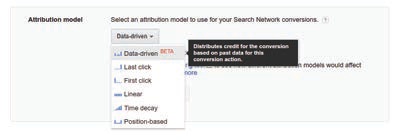Give Credit Where Credit is Due: New Attribution Models to Explore

By Amberly Dressler, Managing Editor
Web professionals only have to think about their own online behavior to understand just how complex their journey to purchase is - moving from search and social to marketplaces and mobile to learn more, engage and find the perfect product.
Even so, many advertisers and the networks they leverage have been slow to adopt an attribution model that gives appropriate credit for sales across the many touchpoints in modern conversion paths; rather, assigning "100 percent credit to the final touchpoints (e.g., clicks) that immediately precede sales or conversions," as Google describes "last-click attribution."
¬ù Since consumers' research and shopping behaviors are more fragmented than ever - increasing the odds of coming into contact with the same brand across different channels - Google is now offering an Attribution Modeling Tool in AdWords so users with sufficient data can integrate one of six different attribution models to give credit where credit is due. These models include last click, first click, linear, time decay, position-based or data driven (in beta). So, how does it all work?

Let's say a shopper reaching a small retail business in the U.S. (with less than 500 daily ecommerce transactions) follows the typical path to purchase (as shown by Think with Google in the image below). This shopper starts on organic search and then interacts with other channels, including (in order) social, generic paid search (e.g., a search for "tablet reviews"¬ù), email, brand paid search (e.g., an "iPad reviews"¬ù query) and direct, before ultimately buying. If that direct visit results in the sale and the advertiser has chosen "last click," then the direct channel would receive 100 percent of the credit for the sale (a familiar model). "First click"¬ù is of course the complete opposite, giving 100 percent credit to the first ad clicked. If, however, the "linear" model was chosen, each touchpoint in the conversion path (all seven here), would share equal credit for the sale, roughly 14 percent each.

In contrast, with "time decay,"¬ù the touchpoints closest in time to the conversion would get the most credit. In this case, the payout is stacked; if the direct channel and branded paid search were "touched"¬ù within a few hours of the sale, they would get a significantly higher credit than a channel that was interacted with days or weeks earlier. The position-based attribution model also distributes credit rather than being all-in at 100 percent in that it will commonly assign 40 percent credit each to the first interaction and the last interaction, while sharing the remaining percentage with the interactions in the middle.
The point here is for advertisers to get a better idea of the value of the keywords in use in order to set bids as well as adjust ads and landing pages based on those findings.
The new (and in beta) data-driven attribution model, which Google seems to favor, shows this idea more clearly - giving "more credit to those valuable clicks on the customer's path."¬ù
For example, if customers click on an ad for "boat rentals in Nevada"¬ù first and then click on "discounted boat rentals in Tahoe"¬ù later and reserve from there - but don't often purchase when selecting "discounted boat rentals in Tahoe"¬ù by itself - the model redistributes credit in favor of the first ad, "boat rentals in Nevada"¬ù because it's shown to provide more conversions than just the second ad alone.
Advertisers will want to look at whether the landing pages are different and need to be modified or if more emphasis needs to be put on certain keywords over others. This has, of course, barely scratched the surface of what these new attribution models mean to advertisers, but Website Magazine has put together a comprehensive guide to analyzing, implementing and optimizing for these new attribution model choices at wsm.co/paymodels.

Subscribe to Our Newsletter!
Latest in Marketing








